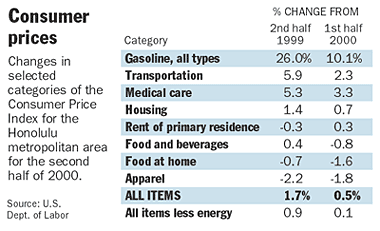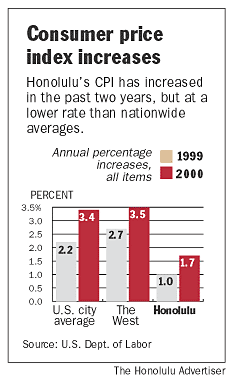 State's economic growth may slow State's economic growth may slow
By Glenn Scott and Frank Cho
Advertiser Staff Writers
Surging oil prices helped push the Honolulu cost of living higher last year, but the increase was just half of the overall U.S. average, offering Hawai‘i consumers stable prices as the local economy continues its gradual growth.
Consumer prices rose 1.7 percent in Hawai‘i during the second half of 2000, according to figures released yesterday by the U.S. Department of Labor’s Bureau of Statistics. The U.S. average was 3.4 percent.
The biggest price increase in the local Consumer Price Index was in gasoline, which jumped 26 percent in the greater Honolulu area from the same period a year earlier; the cost of home fuels, including electricity and natural gas, rose 13.1 percent. The year-over-year increase in gasoline prices was the largest since 1980, when it rose 26.8 percent.
Once energy costs are removed from the index’s market basket of goods and services, prices in Hawai‘i rose just 0.9 percent, the bureau said. Some Honolulu prices actually dropped. Shoppers, for instance, paid 0.7 percent less for groceries and 2.2 percent less for clothing.
Paul Brewbaker, the Bank of Hawai‘i’s chief economist, said yesterday he was surprised that rising energy costs didn’t further inflate local prices. But, he said, as the prices stabilize, consumers will adapt. "Once you get there," he said, "you learn to live with it."
Lower prices can be good news for shoppers, said Henry Wong, chief economist for Honolulu-based City Bank, but the relatively flat pricing structure means that the local economy, although strengthened after a decade-long slump, isn’t generating the vitality that could create more commerce and better-paying jobs.
"This is good news in the sense that you don’t have any inflation," Wong said. "But you always want a little inflation because it means the economy is growing. But we’re moving in the right direction."
Brewbaker agreed. "Notwithstanding the fact we think a nice little recovery has unfolded," he said, "the pressure is not there to turn that into an inflation event."
Conditions could change this year, he said, adding that annual job growth should continue at 2 percent, the tourism industry has been operating near capacity, and interest in home-buying could eventually strain the available real estate inventory, forcing up prices
"I’d be watching rents and home prices," he said.
By the end of this year, he said, Hawai‘i’s growth and inflation rates may rise to meet the declining Mainland rates, a convergence that, contrary to what many believe, is the historic pattern over most of the past 60 years.
Another economic report issued yesterday tracks that dynamic but offers a different reading. Prepared by the state Department of Business, Economic Development and Tourism, the Leading Economic Indicators offer a portrait of a fairly healthy local economy as of last November, with positive signs in the rising number of O‘ahu real estate sales, rising real estate prices and increasing work hours.
In contrast, national and Pacific regional economic measures continued to push the indicator on a six-month decline, leaving state economists to suggest that, because of the downward influence from the Mainland, Hawai‘i’s economy will cool slightly during the second half of this year.
Economist Christopher Grandy said the various economic measures coming out this week are difficult to interpret, although he said Honolulu’s inflation figure was milder than he expected. The conflicting directions of the state and national economies, he said, may mean Hawai‘i is entering a transitional period, as occurred before its recent recovery.
"I think part of the answer may be that there’s a potential turning point here," he said. "We’ll just have to wait and see."
For now, though, the consumer prices reflect more an immediate trend that many retailers have been mentioning in recent months — consumer insistence on bargains. High-end retailers have lately enjoyed steady business, said Carol Pregill, executive director of Retail Merchants of Hawaii. But department and grocery stores, especially, are coping with cautious consumer attitudes and buying patterns based increasingly on holding out for the lowest prices.
"Everything has to be on sale," she said.
She said she suspects consumers are changing their habits as a response to rising credit card debt, the direction of the national economy and, more immediately, higher energy costs.
"It’s fascinating to try to study this," she said. "We have the results, but they don’t give us the answers. That’s left to us to sort out."
When the cost of oil doubled to about $32 a barrel last year, Hawai‘i consumers found themselves paying more for everything from lighting their homes to gassing up their cars. Since then, oil prices have settled to around $28 a barrel. But the prices still paid by many Hawai‘i residents are among the highest since the Gulf War in 1991.
[back to top] |


